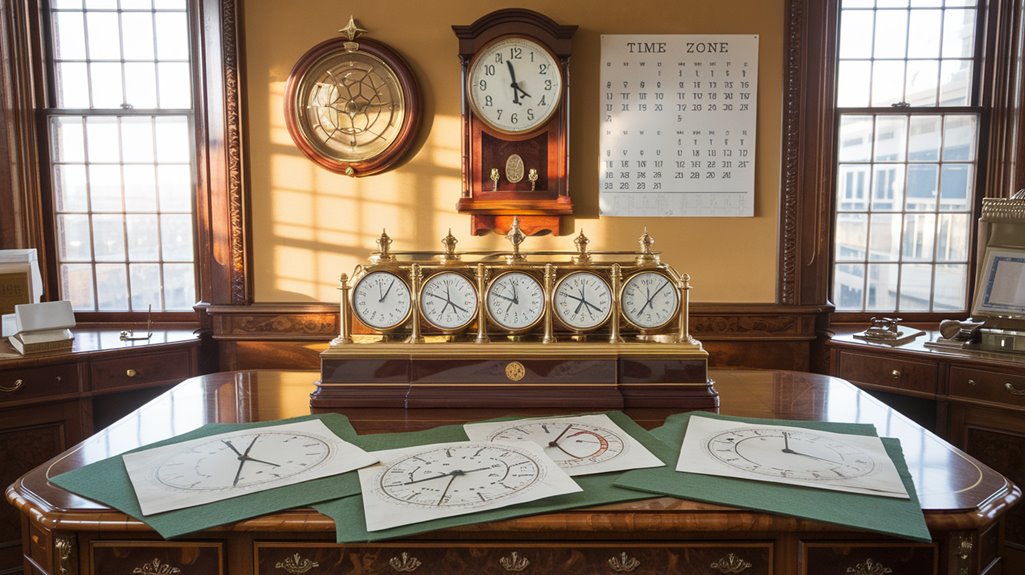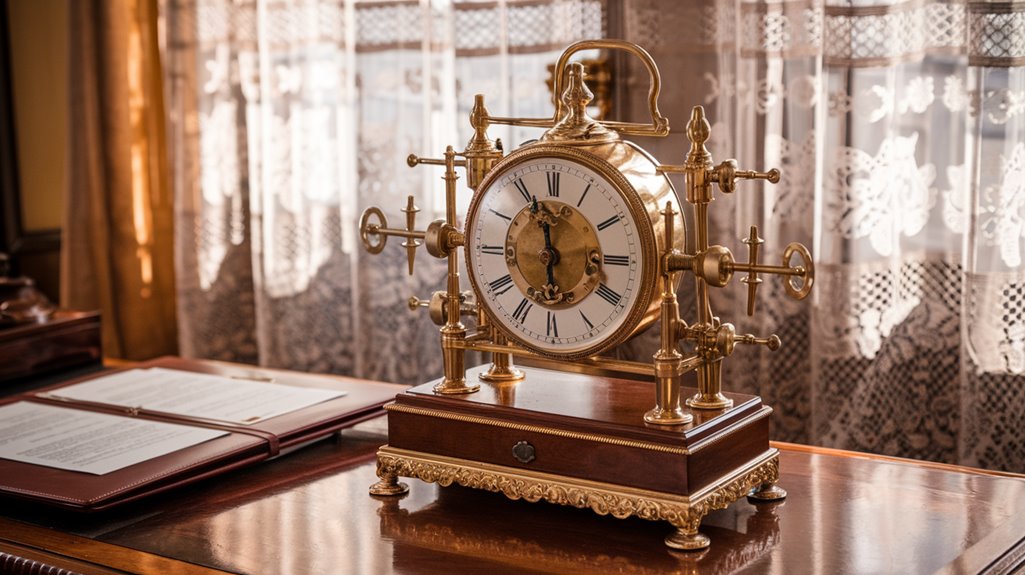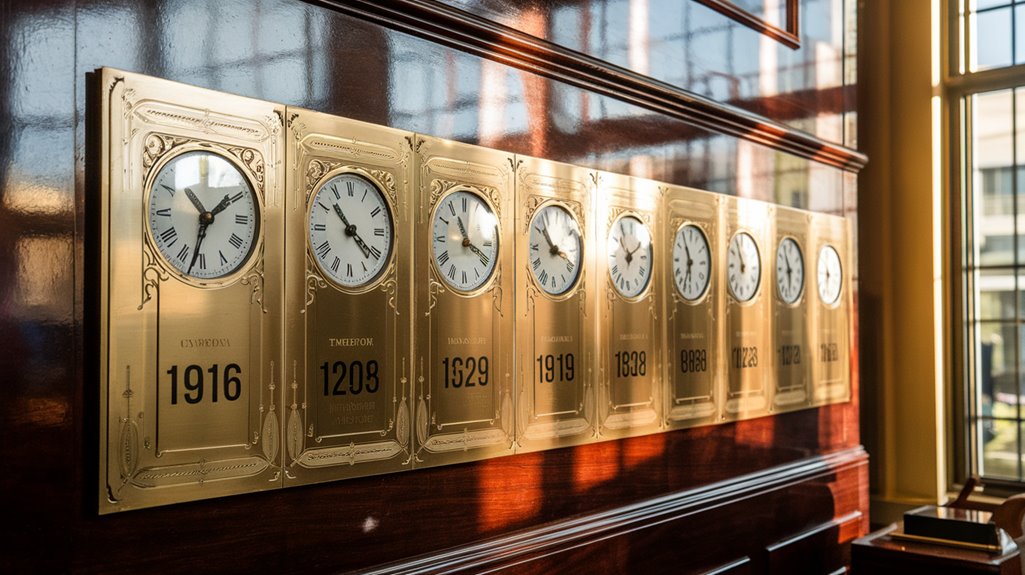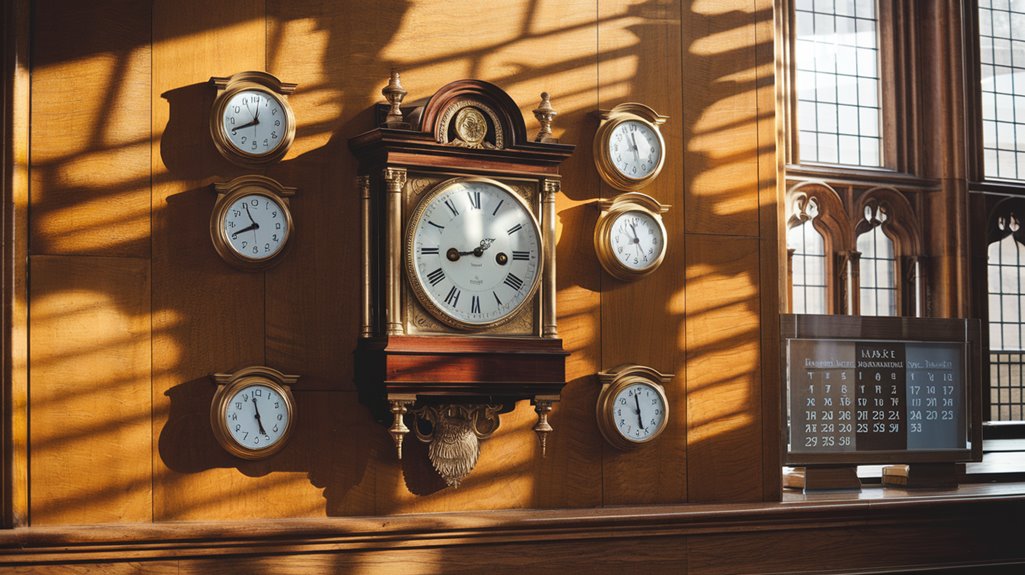An Early Daylight Saving Proposal Suggested Eight Time Changes Yearly
You've heard of springing forward and falling back, but imagine adjusting your clock eight times a year. In 1905, William Willett didn't just want to change time—he wanted to revolutionize how you'd experience daylight throughout the year. His unusual proposal called for shifting clocks by 20 minutes on four separate Sundays in both spring and fall. While this might sound excessive today, you'll find his reasoning surprisingly logical once you understand the era's unique challenges.
The Origins of Willett's Eight-Change System

Although daylight saving time is now a familiar part of modern life, its origins trace back to 1905 when British builder William Willett proposed an innovative but complex system of seasonal clock adjustments.
Willett's vision involved changing clocks by 20 minutes on four consecutive Sundays in April, then reversing these changes across four Sundays in September, totaling eight time changes annually.
In 1907, he published "The Waste of Daylight," arguing that his system would lead to significant energy savings and benefit workers with extended evening daylight. Willett's advocacy was partly inspired by his frustration when his golf games ended early due to darkness.
While the proposal gained support from notable figures like Winston Churchill and politician Robert Pearce, the British House of Commons rejected it in 1908. The concept was inspired by Benjamin Franklin's 1784 essay, which first introduced the idea of adjusting time to maximize daylight usage.
Despite this initial setback, Willett's idea would later evolve into the simpler one-hour system you know today.
Understanding the 20-Minute Time Shift Strategy
Building on Willett's innovative eight-change system, modern sleep experts have developed a more manageable approach to handling time shifts.
You'll find that gradual adjustments of 15-20 minutes each night can help your internal clock adapt smoothly to the time change. This strategy involves shifting your bedtime and wake time earlier while adjusting daily routines, including meals. The concept originated when William Willett campaigned for daylight saving time in Britain back in 1907.
Regular bedtime routines are especially important during time changes to prevent sleep disruption. To make these sleep strategies work effectively, you'll want to maximize morning light exposure and minimize evening light.
Head outdoors early on Sunday after the time change to help reset your body's rhythm. It's essential to maintain consistent sleep habits and get at least seven hours of rest each night.
Public and Parliamentary Response to Multiple Changes
Most historical records reveal sharp opposition to William Willett's multiple time change proposal. When presented to the British House of Commons in 1908, his plan faced public skepticism and was quickly dismissed. The complexity of implementing eight annual time changes proved too challenging for legislators to accept. In a different move, Winston Churchill advocated for DST as a way to improve public well-being.
Today, you'll find similar legislative challenges surrounding time changes, though for different reasons. While Willett's proposal failed due to its complexity, modern opposition focuses on health and safety concerns. The United States first standardized DST in 1966 with the implementation of the Uniform Time Act.
You'll notice that over 63% of Americans want to eliminate seasonal changes altogether, and many states are pushing for permanent standard time. Sleep experts and research organizations strongly support this move, citing increased risks of heart disease, obesity, and mood disorders associated with time changes.
How World War I Simplified the System
While William Willett's complex eight-time-change proposal failed to gain traction, World War I created an urgent need that finally pushed daylight saving time into reality.
You'll find that wartime efficiency demands led to a much simpler system: one spring-forward and one fall-back change per year.
Germany and Austria-Hungary first implemented this streamlined approach in 1916 to conserve coal during the war.
Britain quickly followed suit, and you can see how the domino effect spread to other nations, including the United States in 1918. The Uniform Time Act in 1966 finally established consistent national guidelines for implementing daylight saving time.
The Standard Time Act of 1918 officially established both standard time zones and daylight saving time in U.S. law.
The war's energy conservation requirements made it clear that Willett's multiple changes weren't practical.
Instead, countries adopted this more straightforward system through coordinated efforts, which proved essential for military operations and civilian industries supporting the war effort.
The Legacy of Early DST Proposals

Despite failing to pass initially, early daylight saving proposals left an enduring mark on how we manage time today. You can trace modern DST's roots to innovators like George Hudson and William Willett, who tackled timekeeping challenges with varying approaches.
While Hudson suggested a two-hour shift, Willett's more complex plan involved eight time changes throughout the year. These early proposals sparked significant debates that shaped DST's evolution. The Germans and Austrians became the first to adopt daylight saving time in 1916. Willett's proposal specifically called for advancing clocks by 80 minutes incrementally each spring.
Though farmers and theater owners resisted the change, support from influential figures like Winston Churchill helped keep the concept alive. While it took World War I's practical demands to finally implement DST, you'll find the fundamental ideas from these early advocates still influence current discussions about time management, including modern debates over permanent DST versus standard time.
Modern Perspectives on Multiple Time Changes
Today's ongoing debate about multiple time changes reveals a complex web of health, economic, and energy concerns.
While past generations viewed time changes as a potential energy-saving solution, modern implications paint a different picture. You'll find that recent studies challenge the traditional 1% energy savings claim, often showing minimal or no benefit at all.
The societal acceptance of seasonal time shifts has also declined as health research highlights serious concerns. Modern understanding of time, influenced by special relativity theory, shows that individual experiences of time can vary significantly. Research indicates that time anxiety increases during transition periods as people struggle to adjust their schedules.
You're more likely to experience disrupted sleep patterns, increased stroke risks, and potential heart problems during these adjustments.
While some industries like retail and tourism support DST for extended evening daylight, health experts overwhelmingly recommend adopting permanent standard time.
This tension between economic interests and public health continues to shape policy discussions worldwide, with countries taking varied approaches to resolve these competing priorities.











